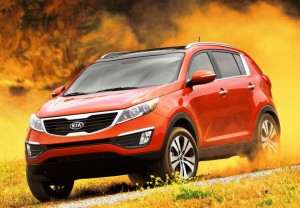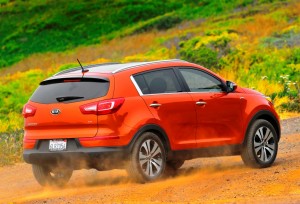In an automotive world where the term “all-new” is frequently abused, the description actually applies to the 2011 version of Kia’s Sportage sport utility vehicle.
This sub-compact “cute ute” has been around for three iterations going all the way back to 1995. Then Sportage was a somewhat crude, body-on-frame five-passenger truck with a meager 94-horsepower 2.0-liter four-banger engine.
A switch to unit-body construction eight years ago vastly improved the Korean-built entry in what by then had become a serious class of vehicles dominated by the Toyota RAV4, Honda CRV, Nissan Rogue and the Ford Escape, to name but a few of the big league players.
The Gen 4 Sportage debuting this August continues the refinement trend evident as the whole class evolves. Sportage is also an attempt by Kia to move away from the “value for money” positioning that is still at the heart of all its entries by substituting more aggressive styling and more sophsiticated features to make it more of an “emotional” buy for the young families that are its target market.
To accomplish this Sportage takes its design cues from the “Kue” concept that debuted during the 2007 North American International Auto Show (NAIAS) in Detroit. So here comes the production version – a longer, lower, sleeker Sportage, at just under 175 inches and overall length. The three additional inches added are used behind the spilt-folding second row of seats to add some badly needed cargo room, which along with a new rear suspension allows for an SAE rated capacity of 56 cubic feet.
Still built on a unit-body frame, Sportage has MacPherson struts in the front and with new “side-load” coil springs to reduce friction. An all-new, multi-link rear suspension system is used in conjunction with new dampers and coil springs mounted separately to minimize intrusion into the space behind the split-folding second row seat.
More upscale items are available to complement the new look, including a segment first air-cooled driver’s seat, keyless entry with a start stop button, and later this year, the next generation of Microsoft Sync technology – dubbed UVO, which simplifies voice commands to speed operation of the phone, am/fm or satellite radio and cd player.
“Sportage offers Kia the opportunity to attract an entirely new and more sophisticated customer,” Michael Sprague, vice president marketing & communications, Kia Motors America (KMA) told TDB. Maybe, but there are many existing owners who will be natural prospects, too.
Power will come from a 2.4-liter, DOHC four-cylinder engine rated at 176 horsepower, which is three more than the now discontinued 173 hp 2.7-liter V6 engine. It’s smooth, and peppy, particularly in front-wheel-drive versions (70% of sales projected) although it’s still noisy at higher operating speeds. When mated with the corporate six-speed automatic transmission shared with Hyundai, which also has versions of the Theta II four-cylinder, as the new engine is called, EPA ratings of 22 city and 31 highway are posted – more than the old V6 engine delivered.
A day of test-driving top of the line EX models in both front-drive and all-wheel drive configurations south of San Francisco, showed that real world economy ranging between 19 mpg to 25 mpg is possible.
All-wheel drive in this class is mostly a marketing ploy, but a new Magna supplied system paired to either a six-speed manual transmission (Base) or a six-speed automatic transmission actually increases the rated towing capacity by 500 pounds to 2,000. (The six-speed manual is also a marketing ploy with only a couple of percent of customers expected to actually buy one.)
Dubbed the Dynamax AWD system, it was co-developed by Kia Motors Corporation and Magna International. Dynamax monitors driving conditions and “anticipates” AWD system requirements, according to KIA, which only react to conditions after they occur. This offers drivers the benefits of improved lateral stability while cornering, as well as the removal of unintended over- and under-steering by reducing traction to the front and rear axles to adjust for what a computer thinks is the driver’s intent.
It delivers 100% of engine torque to the front wheels during normal driving conditions, enhancing fuel economy. When wheel slippage is detected a percentage of the torque is automatically transferred to the rear wheels to help maintain forward momentum. When driving in slippery conditions, such as rain, snow, mud, unpaved roads or off-road, the driver can manually select the “Lock Mode,” distributing torque evenly between front and rear axles up to a speed of 25 mph.
The new Sportage is available in three trim levels – Base, LX and EX. Pricing begins at $18,295 (plus $695 delivery for the boat trip from Korea) for the Base, offering standard convenience features, including air conditioning, power windows, door locks and mirrors, Sirius Satellite Radio capabilities with three months of service, MP3 connectivity and Bluetooth wireless technology.
LX starts at $20,295, and will include standard outside mirrors with LED turn signal indicators and privacy glass.
Moving up to the $23,295 EX trim level offers standard features such as 18-inch alloy wheels, leather-wrapped steering wheel and shift knob.
AWD is a $1500 option. And there is a $3,000 premium package that includes a navigation system and leather seating, a premium sound system and a genuinely useful backup camera.
One thing to be aware of the ride is firm, so firm that the 18-inch wheels and tires might not be a good thing in areas of the country with rough pavement. So be sure to test drive Sportage on your roads to see if you like the firmness and head toss that are present.
Sportage is a global product – built in China, Eastern Europe and Korea – and the U.S. has the ability to take 45,000 of them from Korea through the end of this year.
While hedging on sales projections because of the ongoing uncertainties in the U.S. market, executives expect the new Sportage to sell at least as many of the old model. And if the economy comes back, it will most certainly sell many more. It is also likely that no matter at what volumes, transaction prices will go up for dealers.
.
| 2011 Kia Sportage | |||
| Mechanical | Base | LX | EX |
| 2.4-liter DOHC four-cylinder engine | S | S | S |
| Motor-driven power assisted rack-and-pinion steering | S | S | S |
| Six-speed manual transmission (FWD) | S | — | — |
| Six-speed automatic transmission (FWD) | — | S | S |
| Independent front suspension, MacPherson struts, coil spring, stabilizer bar | S | S | S |
| Independent rear suspension, multi-link, coil springs, stabilizer bar | S | S | S |
| Gas shock absorbers | S | S | S |
| Dynamax AWD system | — | O | O |
| Power-assisted four-wheel disc brakes | S | S | S |
| Four-wheel Antilock Brake System (ABS) | S | S | S |
| Electronic Stability Control (ESC) w/ defeat switch | S | S | S |
| Brake Assist System (BAS) | S | S | S |
| Downhill Brake Control (DBC) | S | S | S |
| Hill-start Assist Control (HAC) | S | S | S |
| Traction Control System (TSC) (tied to ESC function) | S | S | S |
| Tire Pressure Monitoring System (TPMS) | S | S | S |



Is there such a thing as “unwanted traction”?
I’ve never had too much traction.
If you are trying to correct oversteer, understeer or unwanted vehicle yawing, then you want to adjust the “traction” at individual wheels.
In the sense I think you mean, traction is good if the vehicle is under control and behaving as the driver intends.
I bought my Bright Silver LX Sportage today.I have had my eye on this since for 6 months and it is mine mine now.